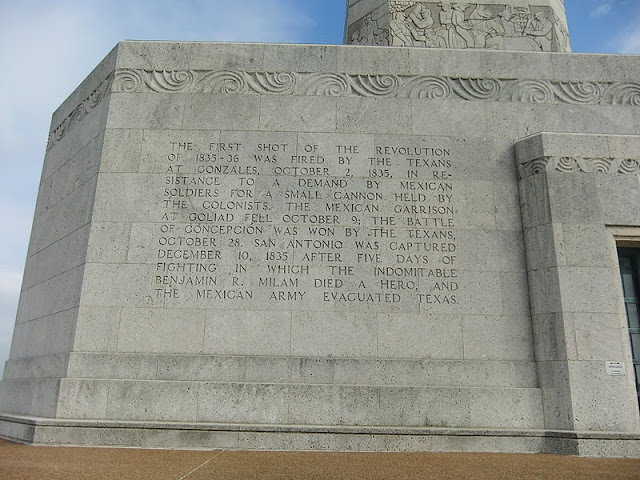The San Jacinto Monument is dedicated to the "Heroes of the Battle of San Jacinto and all others who contributed to the independence of Texas." The monument is a 570-foot shaft topped by a 34-foot star symbolizing the Lone Star Republic.
Visitors can ride up the elevator to the massive concrete and limestone tower to the observation floor at 489 feet above the Battleground. On a clear day, the view encompasses the historic battleground, the marsh restoration and boardwalk, the Buffalo Bayou, the busy Houston Ship Channel, the Battleship TEXAS, and many square miles of surrounding area. The elevator is also operated by the Museum of History
Texian troops under General Sam Houston achieved the independence of Texas by defeating a Mexican Army led by General Antonio Lopez de Santa Anna on April 21, 1836.
The TEXAS is the last of the battleships, patterned after HMS Dreadnought, that participated in World War (WW) I and II. She was launched on May 18, 1912 from Newport News, Virginia. When the USS TEXAS was commissioned on March 12,1914, she was the most powerful weapon in the world, the most complex product of an industrial nation just beginning to become a force in global events.
In 1916, TEXAS became the first U.S. battleship to mount antiaircraft guns and the first to control gunfire with directors and range-keepers, analog forerunners of today's computers. In 1919, TEXAS became the first U.S. battleship to launch an aircraft.
In 1925, the TEXAS underwent major modifications. She was converted to oil-fired boilers, tripod masts and a single stack were added to the main deck, and the 5" guns that bristled from her sides were reduced in number and moved to the main deck to minimize problems with heavy weather and high seas. Blisters were also added as protection against torpedo attack.
The TEXAS received the first commercial radar in the US Navy in 1939. New antiaircraft batteries, fire control and communication equipment allowed the ship to remain an aging but powerful unit in the US naval fleet. In 1940, Texas was designated flagship of US Atlantic Fleet. The First Marine Division was founded aboard the TEXAS early in 1941. April 21, 1948 the Texas was decommissioned.
we did not tour the battleship as it was lunch time!! went to a deli for wonderful BLT sandwiches and chicken dumpling soup. next door to the deli was santa..
Next we went to the Art Car Museum..
they had comtempary art on display too..
next we stopped at the Alabama Ice House, basicly an outdoor bar... we had one drink then headed to Saint Arnolds Brewery..
Saint Arnold was born to a prominent Austrian family in the year 580. Even back in those days the Austrians were famous for their love of beer, and admired for their brewing prowess. Beer was a proud Austrian tradition that was not wasted on young Arnold.
As a young man, Arnold entered the priesthood and began moving his way up that earliest of all career ladders. At the age of 32, he was given the title Bishop, and in 612 was named “Arnold, Bishop of Metz.” (Metz is in France.)
He is said to have spent his life warning peasants about the health hazards of drinking water. Water was not necessarily safe to drink during the dark ages, especially around towns and villages. Nasty stuff. Arnold always had the well-being of his followers close at heart.
Beer, on the other hand, was quite safe. Arnold frequently pointed this out to his congregation. He is credited with having once said, “From man’s sweat and God’s love, beer came into the world.” It goes without saying that the people loved and revered Arnold.
In 627, Saint Arnold retired to a monastery near Remiremont, France, where he died and was buried in 640.
In 641, the citizens of Metz requested that Saint Arnold’s body be exhumed and carried from the monastery to the town of Metz for reburial in their local church – The church where Arnold had so frequently preached the virtues of beer. Their request was granted.
It was a long and thirsty journey, especially since they were carrying a dead bishop. As the ceremonial procession passed through the town of Champignuelles, the tired processionals stopped for a rest and went into a tavern for a drink of their favorite beverage – Beer. Much to their dismay, they were informed that there was only one mug of beer left, and that they would have to share it. That mug never ran dry and the thirsty crowd was satisfied.
Every Saint needs a miracle. The story of the miracle mug of beer spread and eventually Arnold was canonized by the Catholic Church for it. There are many depictions of St. Arnold with a mashing rake in his hand, to identify him. He is honored in July with a parade in Brussels on the “Day of Beer.”
Saint Arnold is recognized by the Catholic Church as the Patron Saint of Brewers. He is recognized by Beer Church as a top-notch, supernatural beer stud.
after waiting in line we paid $7 each for 4 tokens and a glass. this place is wild... there were at least 400 people there, they brought snacks, cards, dice etc... we elected to skip the tour (we have been on brewery tours before).. so we pretty much stood in line, got a beer, went to the back of the line, drank our beer and got another one...
we headed back to Ray's for chicken sliders...
they were very good, Ray is a good cook.


















No comments:
Post a Comment